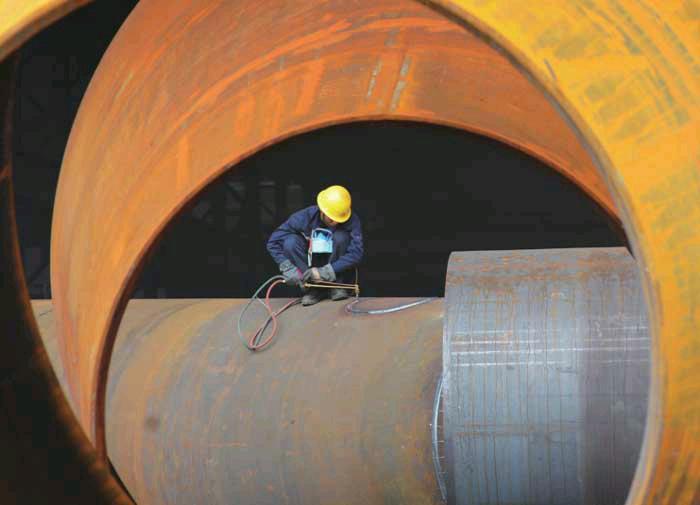How to Reinvigorate The Real Economy
2017-05-12ByXiangJunyong
By+Xiang+Junyong
On April 7 the China Banking Regulatory Commission (CBRC), the countrys banking watchdog, issued a guideline urging the banking industry to focus on serving the real economy. To that end, the commission requires commercial banks to innovate, control risks, intensify reforms, and concentrate on tra- ditional banking practices.
Reinvigorating the real economy is one of the key tasks of economic work to be done in 2017, and is an important means to bring about new growth drivers. In the government work report delivered at the fi fth session of the 12th National Peoples Congress in March, Premier Li Keqiang vowed to transform and upgrade the real economy through innovation because the real economy has always been the foundation of Chinas development. Consequently, it is imperative to recognize and address the following four problems in the real economy.
Industrial hollowing-out
Industrial hollowing-out describes a phenomenon wherein corporations shift focus from their main businesses to credit firms, guarantee companies and other sectors of the virtual economy. As this activity spreads, a countrys industrial development falls into a state of stagnation, shrinking and recession. Industrial hollowing-out is often correlated to the excessive expansion of the virtual economy. The huge gap of investment returns between the real and virtual economy results in a large amount of funds draining from real economy sectors, further intensifying the trend.
As raw material prices and operation costs continuously increase, corporate profits are squeezed and investment returns in the manufacturing industry keep declining. The overall business environment is becoming increasingly unfavorable to businesses in the real economy.
Allured by the thought that auxiliary industries may bring substantial returns and help accelerate capital recycling, many Chinese fi rms have invested heavily in the virtual economy. As a result, the real economy is shrinking and becoming less powerful.
In addition, as market competition becomes increasingly fierce, many traditional industries fail to meet the upgraded market demand. Hence many companies choose to quit their engagement in traditional industries. And since traditional and emerging industries cannot be effectively connected, industrial hollowing-out is further intensified. Resolving this issue is an urgent matter.
Relying excessively on finance
The fi nancial industry refl ects the conditions of a countrys real economy. The fi nancial market itself doesnt create value, but helps real economy sectors create value by providing services to them. A good fi nancial market is able to effectively serve the real economy while at the same time minimizing operational costs for fi nancial institutions.
Nonetheless, it is an indisputable fact that investment in the real economy is diminishing while financial investment becomes increasingly favored.
The percentage of value added created by the fi nancial sector in a countrys GDP is an important barometer of whether the countrys financial sector and real economy are coordinated and whether its economic structure is reasonable.
In 2016, value added of the financial sector accounted for 9 percent of Chinas GDP, while in the U.K. and the U.S., two of the worlds largest financial powers, the figures were only 8 percent and 7 percent, respectively. In Japan, the indicator was below 5 percent. Such a high percentage in China proves that the countrys economy relies excessively on the fi nancial sector.
Against such a backdrop, economic growth is increasingly reliant on debt leverage while economic activities become less stable and predictable. This means that economic growth is accompanied by rising debt risks. An excessively high debt and interest burden has to be covered by income derived from real economy sectors. If corporate profi tability weakens, debt leverage rises, and bubbles keep forming, the economy will face huge risk. Therefore, its crucial to urge fi nancial institutions to focus on their core businesses of serving the real economy and prevent funds from excessively fl owing to the fi nancial sector.
International division of labor
China has maintained fast growth since the reform and opening up policy was adopted in the late 1970s, and it has become the second largest economy in the world. Following signifi -cant improvements in industrial structures and research capabilities, Chinese fi rms in real economy sectors have achieved marked progress in producing high-end, large and smart products. However, Chinas real economy, especially the manufacturing industry, is still at the low end of the international division of labor. The scale of the Chinese economy and the number of Chinese fi rms is large, but their competitiveness is still weak, which is a vivid refl ection of the diffi culties faced by the real economy.
Most Chinese products are still considered to be low-end, and the country still has to import most of the high-end equipment it needs. Most core technologies rely on imports, and strategic emerging industries have an inadequate grasp of independent intellectual property rights. Due to these diffi culties, China is in an unfavorable position in terms of global industrial competition, and is at the low end of the international industrial chain. Ranking at lower industrial levels and with low added value of products, China is seriously affected by fl uctuations in demand in the international market.
Therefore China should try to establish new global value chains wherein Chinese fi rms play a more important role. They should seek to connect companies and industries around the world and unleash Chinas production capacity, in order to avoid staying at the low end of the international division of labor.
Low production efficiency
China is now in a stage of economic restructuring and transformation. Chinas GDP maintains steady and medium to high-speed growth, but its economic effi ciency is still lower than that of major developed economies.
Early in 2010 China replaced the United States to become the worlds largest manufacturing nation in terms of industrial output, but the per-capita output of the Chinese manufacturing industry is merely 16 percent of the United States.
Chinese firms also face more difficulties in exploiting new markets because of an inadequate capacity for innovation and intensified price competition. As Chinese peoples consumption structure changes with higher requirements on product safety, environmental protection, energy consumption and product quality, the gap between supply and demand becomes increasingly prominent. A large quantity of consumption demand has shifted from China to overseas markets because of the inadequate supply of high-quality products and services as well as the quality gap between domestically sold products and imported products.
Therefore China must seek innovationdriven growth and try to climb the ranks in terms of international innovation in science and technology. Innovation should be enhanced to boost Chinas industrial upgrading and economic restructuring and provide new drivers for economic growth.
